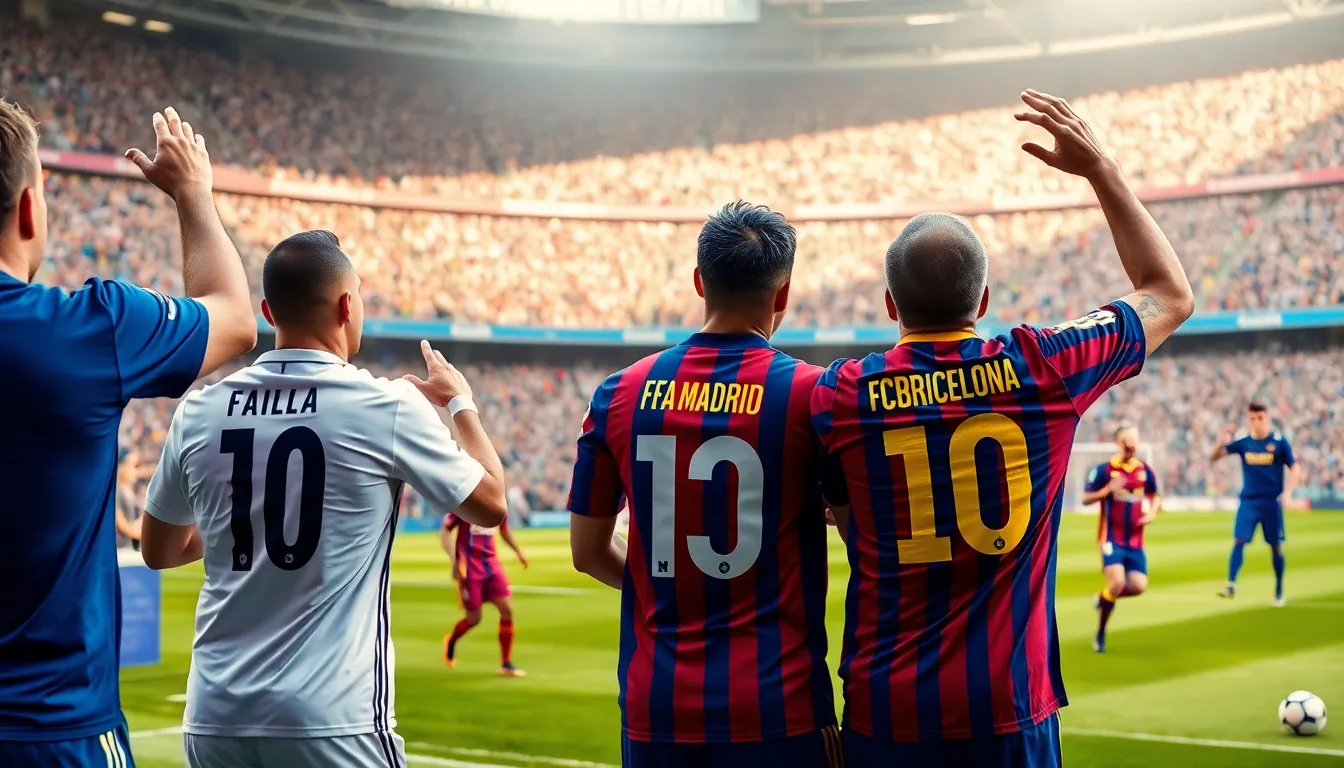The rivalry between Real Madrid and FC Barcelona is one of the fiercest in sports history, captivating fans around the globe. Known as “El Clásico,” these matches showcase not just intense competition but also the unique styles and strategies of both teams. Understanding the composition of each squad is key to appreciating the tactical battles that unfold on the pitch.
As both clubs continue to evolve, their lineups reflect a mix of seasoned stars and emerging talent. From the iconic players who’ve defined eras to the new faces ready to make their mark, the composition of Real Madrid and Barcelona offers a glimpse into their ambitions and competitive edge. This article delves into the current rosters, analyzing player roles and potential matchups that will shape the outcome of this legendary clash.
Table of Contents
ToggleOverview of Real Madrid – FC Barcelone Rivalry
The rivalry between Real Madrid and FC Barcelona, widely recognized as “El Clásico,” embodies the pinnacle of competitive spirit in football. This clash captures not only national pride but also distinct footballing philosophies.
Real Madrid is known for its powerful offensive play, strategically leveraging high-pressing tactics. Key players like Karim Benzema and Vinícius Júnior have consistently demonstrated their ability to turn matches around with individual brilliance.
Conversely, FC Barcelona showcases a possession-based style, emphasizing ball control and intricate passing. Lionel Messi, though no longer with the club, set a standard for upcoming talents such as Pedri and Ansu Fati, who continue this tradition of flair and creativity.
El Clásico often features a blend of seasoned stars and rising prospects. Each team’s composition carries implications for tactical matchups during encounters. Analyses of formations and player performances contribute to predictions about potential outcomes, intensifying anticipation for each clash on the pitch.
With a rich history dating back to their first meeting in 1902, El Clásico has seen countless nail-biting moments. Upcoming fixtures promise to further this legendary rivalry, as both clubs continually strive for supremacy in domestic and European competitions.
Recent Matches and Performance Analysis

Recent matches between Real Madrid and FC Barcelona showcase the intensity and tactical depth of both teams. The performance analysis reveals distinct strengths and emerging challenges that could shape upcoming encounters.
Key Players in Each Team
Real Madrid’s lineup features several key players:
- Karim Benzema: The seasoned striker plays a pivotal role in the attack, consistently finding the net and assisting teammates.
- Vinícius Júnior: The dynamic winger utilizes speed and dribbling skills to create goal-scoring opportunities.
- Luka Modrić: The experienced midfielder excels at controlling the pace of the game, providing valuable passes and defensive support.
FC Barcelona also relies on key contributors:
- Robert Lewandowski: The prolific forward brings goal-scoring prowess, often being the focal point of the attack.
- Pedri: The young midfielder showcases exceptional vision and passing ability, enhancing the team’s offensive flow.
- Gerard Piqué: The veteran defender anchors the backline, offering stability and leadership during critical moments.
Tactical Approaches
Real Madrid employs a high-pressing strategy, emphasizing quick transitions and counter-attacks. This approach allows them to exploit opponents’ defensive weaknesses effectively. They often utilize wing play, leveraging the speed of their wide players to stretch defenses and create space.
FC Barcelona, in contrast, favors a possession-based style. They prioritize ball control and intricate passing patterns, aimed at breaking down defensive lines. Their midfield dominance is crucial for maintaining possession and dictating the match tempo, often resulting in prolonged attacking phases.
Both teams’ tactical approaches continually evolve, making each match an unpredictable and thrilling spectacle as they adapt to each other’s strengths and weaknesses in the ongoing rivalry.
Historical Context of the Rivalry
The rivalry between Real Madrid and FC Barcelona, known as “El Clásico,” spans over a century. This fierce competition not only shapes Spanish football but also ignites regional and cultural identities, making every encounter significant.
Major Matches Recap
Memorable matches define the legacy of this rivalry. Key encounters include:
- 1950: Real Madrid’s 4-2 victory showcased their offensive strength, establishing dominance in the era.
- 1994: Barcelona’s 5-0 rout highlighted their tactical superiority under manager Johan Cruyff.
- 2002: The memorable goal by Zidane in the UEFA Champions League final solidified Real’s status on a global stage.
- 2010: A tactical clash ended with a 5-0 win for Barcelona, demonstrating their possession-style dominance.
- 2020: The most recent match ended 3-1 in favor of Real Madrid, underscoring their resilience and strategic adaptability.
These matches reflect pivotal turning points, influencing fan perceptions and club strategies.
Evolution of Team Compositions
Both teams have seen significant changes in their squad compositions over the years. Notable developments include:
- Real Madrid: Traditionally focused on galácticos—high-profile signings like Cristiano Ronaldo and currently key players like Vinícius Júnior. This strategy promotes immediate impact through star power and skilled forwards.
- FC Barcelona: Historically invested in youth development via La Masia, nurturing talents such as Messi and now Pedri. The focus remains on technical skill and playing style, ensuring long-term success through homegrown talent.
The evolution in compositions reflects shifting tactical philosophies while maintaining competitiveness in both domestic and European tournaments.
Team Compositions for Upcoming Matches
Understanding the team compositions for upcoming matches reveals the strategies and strengths each club will leverage. Both Real Madrid and FC Barcelona continually evolve their lineups, adapting to match conditions and player availability.
Expected Lineups and Strategies
Real Madrid’s expected lineup features a strong blend of experienced leaders and dynamic youth. The starting eleven may include:
- Goalkeeper: Thibaut Courtois
- Defenders: Dani Carvajal, Eder Militão, David Alaba, Ferland Mendy
- Midfielders: Luka Modrić, Federico Valverde, Aurelien Tchouaméni
- Forwards: Rodrygo, Karim Benzema, Vinícius Júnior
Madrid’s strategy typically revolves around quick transitions, exploiting spaces left by opponents. The team often employs a high press to regain possession swiftly, allowing players like Benzema and Vinícius to launch counter-attacks.
FC Barcelona’s anticipated lineup brings together seasoned talents and promising youngsters. It may include:
- Goalkeeper: Marc-André ter Stegen
- Defenders: Sergi Roberto, Ronald Araújo, Andreas Christensen, Alejandro Balde
- Midfielders: Sergio Busquets, Pedri, Frenkie de Jong
- Forwards: Ansu Fati, Robert Lewandowski, Gavi
Barcelona’s style focuses on maintaining possession and dictating the pace of the game. Players such as Pedri and Gavi facilitate intricate passing play, emphasizing ball control to break down opposing defenses.
Player Form and Fitness
Player form critically influences the competitiveness of both teams. Real Madrid tracks the performances of key players, ensuring they maintain peak fitness. Benzema’s ability to strike from various positions and Vinícius’ pace are vital for their scoring potential. Consistent training and tactical drills contribute to their readiness.
For FC Barcelona, the health of players like Lewandowski and the endurance of young stars like Pedri play significant roles. Barcelona’s commitment to injury prevention and fitness regimens supports their high-intensity playing style, essential for sustaining pressure throughout matches.
The mindsets of the coaches and players from both teams shape how they adapt to challenges during high-stakes encounters.
The rivalry between Real Madrid and FC Barcelona remains one of the most captivating in football history. Each match not only showcases the tactical prowess of both teams but also highlights the evolution of their player compositions. With experienced stars leading the way and young talents emerging, the dynamics of El Clásico continue to shift.
As both clubs prepare for future encounters, the anticipation of how their strategies will unfold adds to the excitement. Fans can expect thrilling displays of skill and determination as each side vies for dominance. The legacy of this fierce competition is set to grow, ensuring that every clash is a spectacle worth watching.



